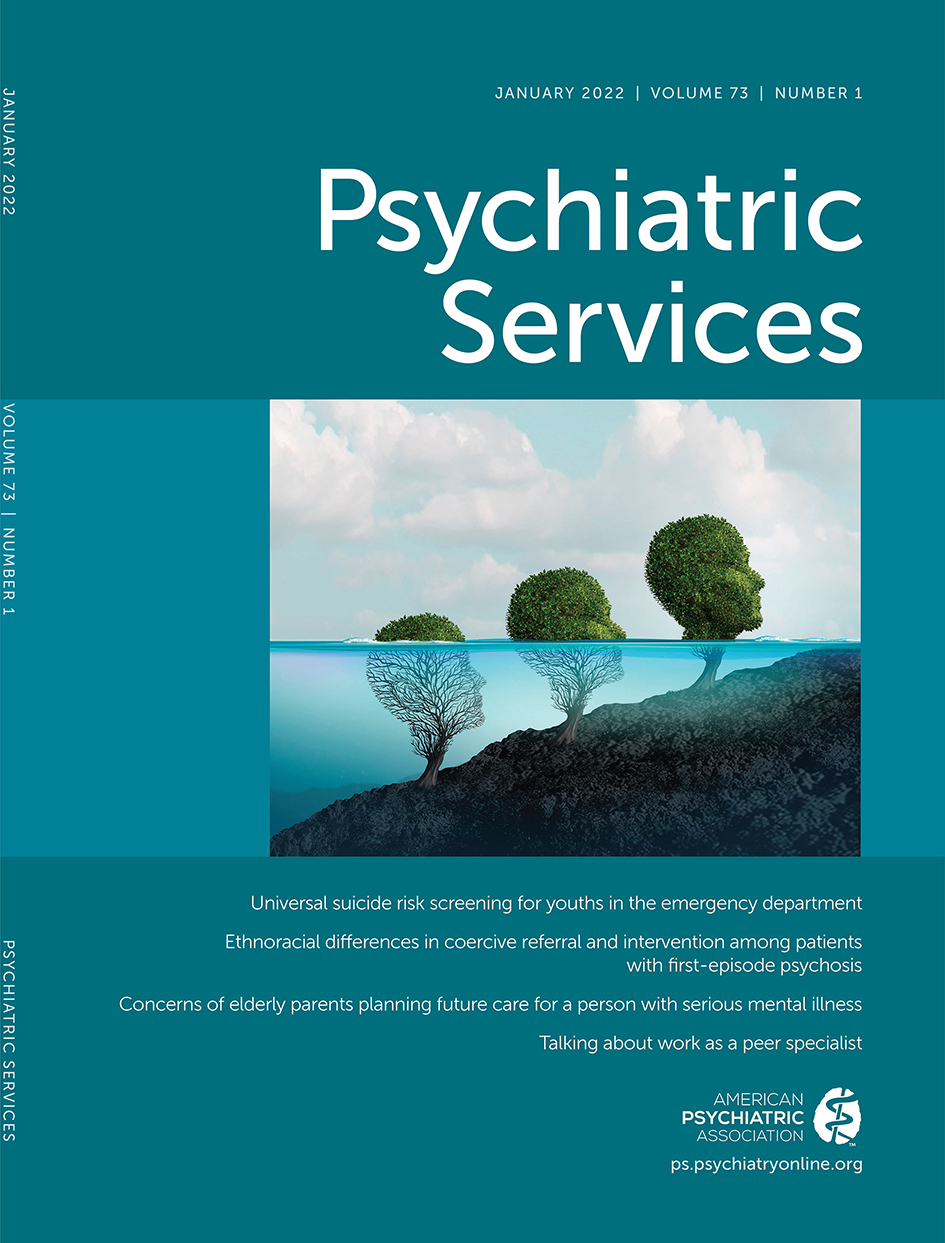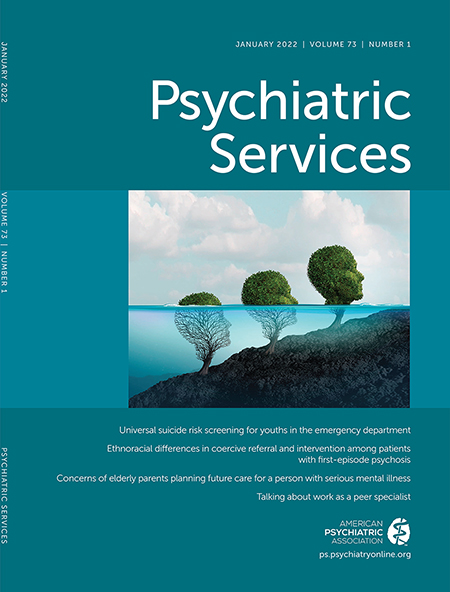Among individuals with psychotic disorders, delay in treatment, commonly measured as duration of untreated psychosis (DUP), has downstream effects on illness course, hospitalization rate, long-term disability, and illness-associated costs (
1). Countries that have implemented early psychosis detection, identification, and treatment efforts report a DUP of 4–12 weeks, starkly contrasting with a DUP of 1.5–3 years in the United States (
2). Reducing DUP requires individuals to be diagnosed as accurately and as early as possible. Yet, numerous barriers exist to the timely identification of clinical high risk for psychosis (CHR-P) or first-episode psychosis (FEP), including logistical (e.g., distance to clinic), systemic (e.g., dearth of providers qualified to administer assessments), and social factors (e.g., perceived community stigma) (
3). Structured assessment tools have been developed to not only improve the accuracy of psychotic diagnoses, but to screen for and categorize risk of psychosis. Unfortunately, clinicians in primary and behavioral health care settings are not trained in the use of these tools, and clinical staff shortages in these settings makes training in these specialized assessments prohibitive.
Telehealth has been identified as a critical mechanism for extending access to specialty psychosis interventions to underserved communities (
4) and can be actualized through academic telehealth partnerships (
5). Although telehealth is a valid and reliable alternative to traditional in-person psychological assessments (
6) and the use of technology in treatment particularly appeals to young people (
7), tele-evaluation services for psychosis risk syndromes are not prevalent, and, to our knowledge, such services have not been systematically pilot tested or evaluated.
We developed the Central Assessment of Psychosis Service (CAPS), a pilot hub-and-spoke tele-evaluation service operated out of an academic medical center (the hub) that extends specialized screening and assessment of FEP and CHR-P to resource-scarce care settings (the spokes) throughout Washington state. CAPS offers direct tele-evaluation to individuals (ages 13–40) exhibiting signs and symptoms of psychosis. The service aims to identify young people in a prodromal or early psychosis phase of illness in order to reduce DUP and to assist state-funded coordinated specialty care (CSC) programs with admission and care decisions. This column is intended to document the development of this novel service and the pragmatic considerations involved in launching this service.
Program Development
Several technical, procedural, and regulatory processes were needed to facilitate the structure and sustainment of CAPS. These processes are outlined below.
Financial model.
CAPS was initially funded by a philanthropic foundation pilot grant, which allowed for a 1-year start up and onboarding of five sites (spokes). After initiation of this five-spoke pilot program, CAPS received state mental health block grant funding, enabling the service to be extended to CSC programs statewide. Billing codes used by the hub site included the originating site facility fee, which could be billed for use of clinic space during telehealth encounters. Billing codes used by the spoke sites were related to psychiatric diagnostic evaluation. Although other billing codes relevant to psychological testing are relevant to CAPS (e.g., for psychological testing evaluation, test administration and scoring) in Washington, only psychiatric diagnostic evaluation can be billed by using the code for the telehealth modality, and the initial assessment must first be completed by the intake agency. Although temporary federal and state waivers have permitted the use of additional billing codes for telehealth-based assessments during the COVID-19 pandemic, it is unknown whether these adaptations will persist.
Staffing.
During the initial 6 months of prelaunch program development, a 10% full-time equivalent (FTE) faculty position was devoted to the service. During this time, the concept was researched, professional and institutional consultation occurred, organizational barriers and facilitators were assessed, a library of screening assessments was purchased, and initial drafts of the protocol were iteratively developed. The University of Washington (UW) School of Medicine (SOM) provided legal and administrative consultation, facilitated contractual agreements with the spoke sites, and helped to coordinate CAPS with other UW Medicine telehealth services. During the next 12 months, the addition of a 40% FTE position for a postdoctoral fellow (an unlicensed clinical psychologist obtaining clinical hours toward state licensure) permitted for further development of the protocol and supporting materials, agency engagement and assessment, and a soft launch with the first site, followed by a monthly onboarding schedule of four additional sites. We have found that a minimum of a 40% FTE postdoctoral position and a 10% FTE faculty position enables clinical and administrative oversight for two CAPS assessments per month.
Credentialing and contracts.
For CAPS assessors to engage in clinical practice at agencies outside the hub, each of the five CAPS-enrolled agencies required approval from the SOM to be identified as a site of practice (SoP). Identification as a SoP extended medical malpractice liability coverage to CAPS assessors engaging in clinical practice at these agencies and permitted the SOM to conduct credentialing by proxy, in which outside agencies accept credentials established by the SOM, bypassing the need for credentialing of CAPS assessors at each agency and allowing each agency to grant practice privileges to the CAPS assessors. Once SoP had been established, individual contractual agreements between the school and each participating agency were prepared, approved, and signed.
Telehealth training.
CAPS personnel (e.g., assessors and a clinical supervisor) underwent required telehealth training and privileging through UW Medicine. This process included completion of online modules detailing etiquette for telemedicine encounters, competence in telehealth technology platforms, documentation and billing requirements, telehealth risk management, and mandatory reporting requirements, as well as ongoing consultation with UW Medicine’s compliance officers and telepsychiatry service directors and administrators.
Core testing battery.
For each testing domain (cognitive, psychodiagnostic, personality), the literature was examined to determine which measurement tools would provide the most comprehensive assessment and had been validated for use with the client population (i.e., young adults with symptoms of psychosis) and for remote administration. This process resulted in a core battery consisting of the telephone version of the Montreal Cognitive Assessment as the cognitive screening tool, the Prodromal Questionnaire–Brief Version as the psychosis screening tool, the Structured Interview for Psychosis–Risk Syndromes to assess psychosis risk syndromes, the clinician version of the Structured Clinical Interview for DSM-5 to assess comorbid conditions, the Cultural Formulation Interview to aid in the development of a culturally informed conceptualization, and the adult and adolescent versions of the Personality Assessment Inventory to assess various domains of personality and psychopathology. Each of the core assessments, as well as individualized supplemental assessments, were amenable to remote administration.
Policies and procedures.
Technical guidelines included specifications regarding the remote testing environment as well as the identification of a point person at the spoke site for onsite testing support, records transfer, and management of safety concerns as needed. To reduce agency burden and facilitate adherence to technical guidelines, participating agencies received webcams with microphones, headsets, and electronics-safe disinfectant wipes to promote safe use of the hardware. Administrative guidelines detailed the process of enrolling clients into the service, roles and expectations for each testing session, documentation policies, telehealth billing procedures, and issues related to privacy and data security (e.g., Health Insurance Portability and Accountability Act compliance). Notably, CAPS providers do not have access to SoP electronic health records. Therefore, pertinent records are obtained from the SoP clinical point of contact via encrypted e-mail or secure facsimile, and the CAPS assessor securely transmits documentation to the clinical point of contact for direct upload into the SoP’s electronic health records. Clinical guidelines detailed eligibility criteria; state regulations for obtaining and documenting consent; scheduling, cancellation, and communication policies; and emergency protocols. Finally, a practitioner protocol outlined materials needed by CAPS assessors, documentation requirements, billing codes, note templates, CAPS phone screening assessments, and a SoP contact list to aid in scheduling and in-session communication needs. Protocol modifications necessitated by the COVID-19 pandemic included the addition of telehealth home readiness checks (e.g., bandwidth, hardware, private space, emergency contact information), creation of home-based telehealth visit instructions, and updated checkout procedures to ensure SoP treatment teams were updated on client status after a testing session.
Eligibility criteria.
Because funding and regulatory restrictions prohibit open referrals, the CAPS service is currently available only to individuals (ages 13–40) who are associated with a CSC team’s parent agency and are under consideration for admission by the CSC team. Ideal referrals are cases in which the site is unable to determine through conventional methods whether the individual meets criteria for FEP, operationalized by the state as meeting criteria for a schizophrenia spectrum disorder for less than 2 years. Exclusion criteria include psychotic symptoms secondary to a pervasive developmental disorder, mood disorder, medical condition, and/or drug or alcohol use; an IQ <70; or a diagnosed neurological disorder.
Postassessment procedures.
Findings suggesting the presence of a primary psychotic disorder most commonly result in a recommendation to the referring CSC team to admit the individual. The CSC team is also provided with tailored treatment recommendations aligned with the client’s and team’s strengths and resources. Because no specialized CHR-P services are available in the state, individuals who test positive for CHR-P, or for whom putative secondary causes of psychosis have not been ruled out, receive a recommendation for provisional admission to the referring FEP team or its parent agency, as well as recommendations for medical or neurological evaluations needed to rule out secondary causes of psychotic-like experiences. Those who do not meet criteria for FEP or CHR-P receive case-by-case treatment recommendations in coordination with administrators from the state’s Developmental Disabilities Association and Department of Social and Health Services.
Agency engagement.
All CSC teams in the state were notified of the opportunity to participate in CAPS. All indicated that the service would be of benefit and expressed interest in participating. The first five teams that indicated readiness to become a SoP were enrolled. During the onboarding for each site, CAPS faculty delineated the aims and functions of the service, approximated the referral volume on the basis of site data from the past year, established SoP agreements, provided a review of the CAPS protocol and materials, and delineated workflows. The active enrollment phase consisted of regular bimonthly calls to discuss potential referrals, weekly testing status updates, and attendance at agency team meetings to provide testing feedback to the clinical team.
Discussion
Pilot testing of CAPS among five CSC sites suggested that the service is acceptable, appropriate, and feasible. Although such a service cannot address all barriers to optimal psychodiagnostic assessment for high-risk populations, CAPS may represent a pragmatic solution to redress several of the systemic, logistical, and social barriers associated with a lengthy DUP, including paucity of credentialed practitioners, limited access to standardized testing materials and scoring software, distance to clinic, and perceived stigma.
CAPS programmatic metrics and clinical data collection are underway and will be reported at a future date. We are particularly interested in the extent to which systematic tracking of CAPS referrals and assessment data will provide evidence of reduced DUP, increased measurement-based care decision making, and improved assessment access among low-income and rural populations. If expanded to other health care settings, CAPS could enhance incidence estimates for CHR-P and FEP, help determine geographic need for CHR-P services on the basis of incidence data, and facilitate a staging process for titrating care that is based on patient risk of developing a serious mental illness (
9). CAPS is poised to meet these objectives with financial and contractual models that enable practitioners in primary care, mental health, and correctional settings to refer young people for initial screening and, if warranted, full psychodiagnostic evaluation. Although CAPS is starting with a narrower referral base, we believe this is an important first step toward broader access to specialized psychodiagnostic evaluations in the United States.

